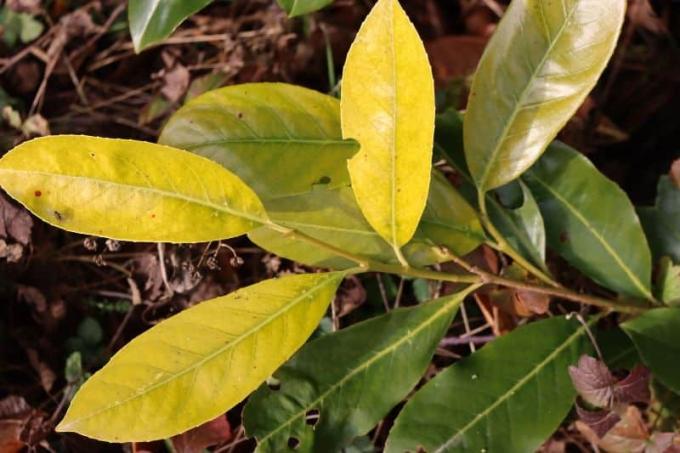

Table of contents
- Distinguishing between gold and other kiwi species
- What varieties of Gold Kiwi are there?
- Constituents of yellow kiwi fruit
- How much does a yellow kiwi plant cost?
- cultivation in Germany
Kiwis, the hairy, green and sour-tasting fruit, are available in every supermarket. Many a hobby gardener even cultivates such a plant in their own garden and harvests the fruit that is as tasty as it is healthy. Yellow-fleshed varieties that taste sweeter and milder have also been available for several years. The golden kiwi plant can also be purchased in specialist shops, but it does not thrive in every region.
Distinguishing between gold and other kiwi species
Actinidia chinensis, also known as Chinese gooseberry, is native to southern China. The species is closely related to the green-fleshed kiwi (bot. Actinidia deliciosa) related. The plants are mainly grown in the climatically favorable regions of New Zealand, China, the Mediterranean (v. a. Greece) as well as California's. In contrast to the green-fleshed varieties, the fruits have a smooth, slightly downy skin and soft, yellow flesh. All currently commercially available varieties of the golden kiwi require a warm climate with at least 240 frost-free days, as the fruits generally ripen later than the hardy green ones Species.
What varieties of Gold Kiwi are there?
Under the brand name 'Gold-Kiwi', the Zespri group sells the 'Hort16A' variety, which is cultivated in New Zealand and differs from the classic green kiwi in terms of appearance and taste. Yellow kiwis are higher in sugar and lower in acid than the green variety, which is why they taste sweeter. They are also considered to be more exotic, as their aroma is reminiscent of tropical fruits such as mango. There are also other varieties that are not (yet) known in this country. These include, for example:
- 'golden kiwi': serious loss of importance due to the rampant PSA bacterium between 2010 and 2013
- 'Sun Gold': new variety from Zespri, less susceptible to disease than Goldkiwi, less sweet taste, patented under the name 'Gold3'
- 'EnzaRed': also bred by Zespri, golden flesh with red inner ring, taste reminiscent of raspberries
- 'Exotic Sun': new semi-hardy hybrid, but needs protection
- 'MinkiGold': new yellow hybrid variety, exclusively female plants
- 'Zoreli': protected variety, fruits ripen relatively early between September and November
- 'Xixuan': Chinese variety, fruits taste a little bit like banana
Constituents of yellow kiwi fruit
Although yellow and green kiwifruit differ in taste, they do not differ significantly in their ingredients. Golden kiwis contain more sugar than the green varieties. So for the variety 'SunGold' with approx. 12 grams per 100 grams of fruit weight has a slightly higher sugar and therefore calorie content than specified for comparable green-fleshed varieties, the average is about nine grams of sugar per 100 grams contain. Green kiwis provide around 61 kilocalories per 100 grams, yellow ones only slightly more at around 63 kilocalories.

Otherwise, both types are considered with their high content of vitamin C as well as other important vitamins such as vitamin E, vitamin K as well as some vitamins from the B group (B1, B2, B3) and minerals (albeit to a lesser extent) than very much healthy. Incidentally, yellow kiwifruit contain more vitamin C on average than their green relatives: 100 grams of the golden fruit cover almost twice the daily requirement.
How much does a yellow kiwi plant cost?
A golden kiwi plant between 60 and 80 centimeters high costs between around ten and 17 euros in specialist shops. However, buying a plant is not enough: Usually only the female specimens are offered, you have to buy the appropriate male pollinator yourself. A male 'Matua' at a comparable height between 60 and 100 centimeters costs around 20 to 25 euros, depending on the provider.
Tip:
After planting the kiwi plants, you need patience, because it can take three to four years - sometimes even more - until the first flowers and fruits appear.
cultivation in Germany
Cultivation in the garden is only conceivable in the wine-growing regions. If you still want to try it, you should cultivate the plants in tubs and keep them cool, but frost-free and bright over the winter. An unheated conservatory or a greenhouse, for example, is suitable for this. However, moving it back and forth is quite difficult, since the shoots of the liana grow up to three meters long and should not be cut back significantly every year. Plants of the desired species are available from almost all specialist dealers.
 garden editorial
garden editorial I write about everything that interests me in my garden.
Learn more about shrubs

Cherry laurel has yellow / brown leaves: what to do?
Cherry laurel is one of the hardy garden plants in the garden. Nevertheless, it can happen that the leaves of the cherry laurel turn yellow or brown. The causes are manifold. Since some can kill the cherry laurel, you should investigate.

12 native evergreen shrubs & woody plants
Dreary, bare trees and bushes in winter? It doesn't have to be. Even in the European climatic conditions, native, evergreen trees thrive splendidly. The variety of species even enables the gardener to adapt his privacy hedge exactly to his garden design. This guide presents the most beautiful native and evergreen shrubs and woody plants.

Curb Vinegar | Does bucket or root barrier help?
Vinegar trees like to spread in the garden and sometimes even drive other plants away. However, this can be avoided by curbing the growth of the trees. You can find out which methods are best suited for this here!

Rhododendron has dried up: how to save it | Rododendron
Even if the rhododendron is withered and no longer sprout, it does not have to be dead. The plant can look completely dried up above ground, but there is often still life in the roots. It is therefore worth taking appropriate measures to save the flowering shrub.

Winter jasmine, Jasminum nudiflorum | Care, propagation & pruning
The winter jasmine is a relatively frugal and robust plant that can cope with many different site conditions. The plant enchants with bright yellow flowers in winter and tolerates deep sub-zero temperatures very well. It should be pruned regularly and is easy to propagate.

Ball Tree: Care from A – Z | These 9 varieties are suitable for ball trees
Ball trees adorn many a garden, front yard and entrance area. They require little space. Their trunk thickens with age, but its height remains the same. The spherical crown is easy to trim. Nevertheless, they offer everything that makes a tree.
